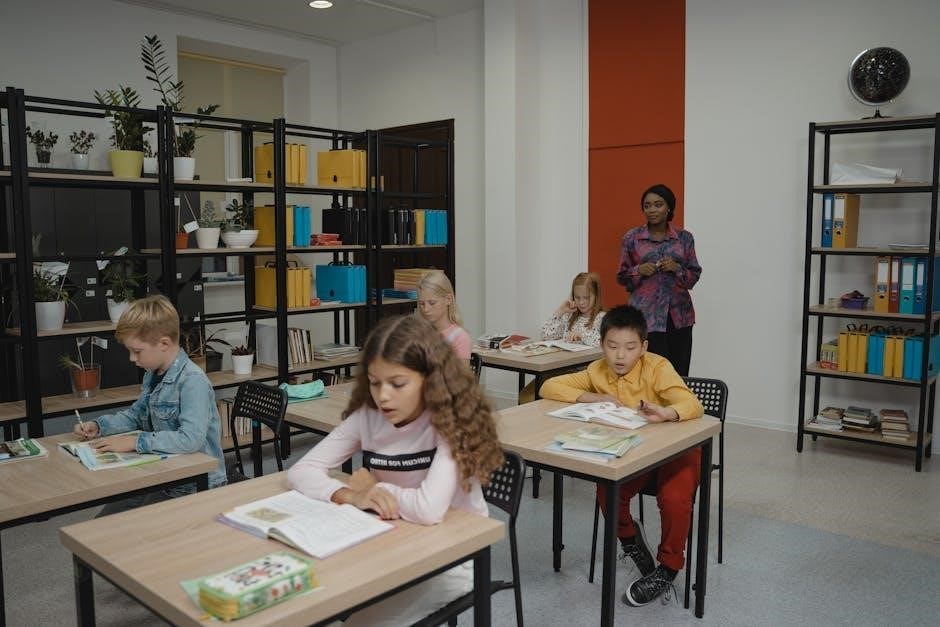Reading comprehension for Grade 2 focuses on building foundational skills to understand and interpret texts. It involves identifying main ideas‚ making inferences‚ and connecting prior knowledge to new information. Grade 2 students learn to read independently and engage with stories‚ fostering a love for reading while improving fluency and vocabulary. PDF resources provide accessible and structured materials for practice‚ making learning fun and effective.
1.1 Definition and Importance of Reading Comprehension
Reading comprehension is the ability to read‚ understand‚ and interpret written texts effectively. It involves identifying main ideas‚ making inferences‚ and connecting new information to prior knowledge. For Grade 2 students‚ mastering this skill is crucial as it lays the foundation for academic success. Reading comprehension helps children develop critical thinking‚ improve communication skills‚ and foster a deeper appreciation for literature. It also enhances their ability to analyze information‚ solve problems‚ and express ideas clearly. By practicing comprehension‚ students build confidence in reading independently‚ which is essential for lifelong learning. PDF resources specifically designed for Grade 2 provide structured and engaging materials to make learning fun and effective. These tools ensure students develop the skills needed to excel in reading and beyond‚ making comprehension a cornerstone of their educational journey.
1.2 Role of PDF Resources in Learning

PDF resources play a vital role in enhancing reading comprehension skills for Grade 2 students. These documents are easily accessible‚ printable‚ and can be used both in classrooms and at home‚ making learning convenient and flexible. PDFs often include short stories‚ engaging passages‚ and accompanying questions that cater to young learners’ attention spans. They provide structured activities such as multiple-choice questions‚ open-ended responses‚ and sequencing exercises‚ which help students practice various comprehension techniques. Many PDF resources incorporate visual aids and illustrations‚ making complex concepts more relatable and fun for children. Additionally‚ these materials are designed to align with curriculum goals‚ ensuring that students meet key learning objectives. Teachers and parents can use these PDFs to create engaging lesson plans‚ track progress‚ and reinforce skills. Overall‚ PDF resources are invaluable tools that support the development of strong reading comprehension abilities in Grade 2 students‚ fostering a love for learning and setting the stage for future academic success.

Benefits of Using Grade 2 Reading Comprehension PDFs
Grade 2 reading comprehension PDFs enhance fluency‚ improve understanding‚ and foster critical thinking. They provide structured activities‚ engaging stories‚ and clear questions‚ helping students develop essential skills. PDFs are versatile‚ accessible‚ and support independent learning‚ making them invaluable educational tools.
2.1 Improved Reading Fluency
Grade 2 reading comprehension PDFs significantly enhance reading fluency by providing engaging‚ short stories that match the reading level of young learners. These stories are designed to be simple yet captivating‚ helping students build confidence and rhythm while reading. The clear and repetitive structure of the texts allows students to practice reading aloud smoothly‚ improving their ability to recognize words and phrases effortlessly. Many PDF resources include visual aids like illustrations‚ which help students connect the story to its meaning‚ further boosting their fluency. Additionally‚ the repetition of reading similar texts and answering questions reinforces their ability to read with accuracy and expression. Over time‚ this consistent practice leads to improved reading speed and a more natural flow‚ making reading a more enjoyable and automatic process for Grade 2 students. These resources are particularly beneficial for young readers‚ as they provide a structured and fun way to develop essential reading skills.
2.2 Enhanced Understanding of Text
Grade 2 reading comprehension PDFs are designed to deepen students’ understanding of texts by incorporating engaging stories and targeted questions. These resources often feature short‚ thematic passages that align with young learners’ interests‚ such as animals‚ adventures‚ and daily life. Each story is followed by comprehension questions that prompt students to identify main ideas‚ recall details‚ and make simple inferences. The clear and straightforward language of these texts ensures that students can focus on understanding without being overwhelmed by complex vocabulary. Visual aids‚ such as illustrations‚ further enhance comprehension by providing context and helping students connect the story to its meaning. Additionally‚ many PDFs offer activities that differentiate between fact and fiction‚ teaching students to critically analyze what they read. By consistently practicing with these materials‚ Grade 2 students develop a stronger grasp of narrative structures and the ability to extract key information from texts‚ laying a solid foundation for advanced reading skills in the future.

2.3 Development of Critical Thinking Skills
Grade 2 reading comprehension PDFs play a significant role in fostering critical thinking skills among young learners. These resources often include activities that encourage students to analyze texts‚ identify patterns‚ and make logical connections. For instance‚ sequencing exercises require students to arrange events in order‚ promoting an understanding of cause-and-effect relationships. Additionally‚ open-ended questions prompt students to think deeply about the motivations of characters‚ the themes of stories‚ and the implications of events. These exercises help students move beyond mere recall and develop the ability to evaluate and interpret information. Critical thinking is further enhanced through fact-and-fiction differentiation tasks‚ which teach students to discern between realistic and imaginative elements in a text. By engaging with these structured activities‚ Grade 2 students build the skills necessary to approach complex texts with confidence and independence. These exercises also lay the groundwork for more advanced analytical tasks in higher grades‚ ensuring a smooth transition as students progress in their academic journey.

Key Features of Grade 2 Reading Comprehension PDFs
Grade 2 reading comprehension PDFs feature engaging stories‚ multiple-choice and open-ended questions‚ and visual aids. These elements cater to young learners‚ making complex concepts accessible while enhancing understanding and retention through interactive and visually appealing content.
3;1 Short and Engaging Stories
Grade 2 reading comprehension PDFs often include short and engaging stories designed to capture young learners’ attention. These stories are typically 120- long‚ making them manageable for early readers. Themes revolve around relatable topics such as animals‚ adventures‚ and daily life‚ ensuring relevance and interest. The language is simple and clear‚ catering to both native English speakers and ESL students. Each story is followed by comprehension questions that check understanding and encourage critical thinking. Visual aids like illustrations accompany the texts‚ helping students connect the narrative with visuals. This approach makes learning interactive and fun‚ fostering a love for reading while building essential comprehension skills. The brevity of the stories ensures that young learners stay focused‚ while the engaging themes keep them motivated. These features align with curriculum goals‚ providing a solid foundation for future reading success.

3.2 Multiple Choice and Open-Ended Questions
Grade 2 reading comprehension PDFs typically include a mix of multiple choice and open-ended questions to assess understanding. Multiple choice questions provide students with clear options‚ making it easier to identify correct answers and build confidence. These questions often focus on key details‚ such as the main idea‚ characters‚ or settings. Open-ended questions‚ on the other hand‚ encourage students to think critically and express their thoughts in their own words. This format helps develop writing and communication skills while deepening comprehension. The combination of question types caters to different learning styles‚ ensuring that all students can demonstrate their understanding effectively. Additionally‚ these questions are designed to align with curriculum goals‚ making them a valuable tool for both classroom and homeschool learning. The structured format of these questions also helps prepare students for future standardized tests and academic challenges.
3.3 Visual Aids and Illustrations
Visual aids and illustrations play a crucial role in Grade 2 reading comprehension PDFs‚ as they help students connect with the material on a deeper level. These resources often include colorful pictures‚ diagrams‚ and charts that complement the text‚ making stories more engaging and accessible. For young learners‚ visuals can aid in understanding complex ideas and provide context‚ especially for those still developing their reading skills. Illustrations also enhance vocabulary acquisition by providing visual cues‚ making it easier for students to grasp unfamiliar words. Additionally‚ visual aids can support English language learners by bridging the gap between text and meaning. Many PDFs incorporate images that prompt critical thinking‚ encouraging students to analyze and interpret the connection between the text and the visuals. This integration of visual and textual elements creates a comprehensive learning experience‚ fostering both comprehension and creativity in Grade 2 students. The use of visual aids ensures that learning is both enjoyable and effective‚ catering to diverse learning styles and abilities.

Types of Exercises in Grade 2 Reading Comprehension PDFs
Grade 2 reading comprehension PDFs feature varied exercises‚ including short story comprehension‚ fact vs. fiction differentiation‚ and sequencing activities. These exercises help students develop essential skills like understanding narratives‚ identifying details‚ and organizing events logically.
4.1 Short Story Comprehension
Short story comprehension exercises in Grade 2 reading comprehension PDFs are designed to help students understand and interpret narratives. These stories are typically short‚ engaging‚ and written in simple language‚ making them accessible for young readers. Each story is followed by a series of questions that test students’ ability to recall details‚ identify the main idea‚ and make basic inferences. The themes of these stories often revolve around familiar topics such as animals‚ daily life‚ and adventures‚ which captivate students’ interest and make learning enjoyable. Additionally‚ the stories are accompanied by visual aids like illustrations‚ which help students visualize the content and improve their understanding. The length of these stories‚ usually between 120-‚ ensures that they are not overwhelming for second graders while still providing enough content for meaningful comprehension practice. By completing these exercises‚ students develop their ability to process information‚ recognize sequencing of events‚ and answer questions accurately. These activities also serve as a foundation for more complex reading skills in later grades.
4.2 Fact and Fiction Differentiation
Fact and fiction differentiation is a key exercise in Grade 2 reading comprehension PDFs‚ helping students understand the difference between real and imaginary events. These activities often present short passages‚ some based on real-life situations and others on fantastical scenarios‚ followed by questions that ask students to identify which parts are true or made-up. For example‚ a story about dragons would be classified as fiction‚ while a passage about daily routines would be factual. This skill is essential for developing critical thinking and preparing students to navigate various types of texts in the future. The exercises are designed with simple language and engaging themes‚ such as animals or adventures‚ to keep young learners interested. Visual aids and clear instructions support students in grasping the concept. By practicing fact and fiction differentiation‚ students improve their ability to analyze texts and make informed judgments‚ a skill that extends beyond the classroom into real-life reading experiences.
4.3 Sequencing Activities
Sequencing activities in Grade 2 reading comprehension PDFs help students organize events in a logical order‚ enhancing their understanding of stories and texts. These exercises typically involve short stories or passages‚ followed by questions or tasks that ask students to arrange events chronologically; For example‚ a story about a day at the park might include sentences or pictures that students must put in the correct sequence; This skill is crucial for developing narrative comprehension and memory recall. Many PDF resources include visual aids‚ such as numbered events or timelines‚ to support young learners. Sequencing activities also encourage the use of transitional words like “first‚” “next‚” and “then‚” which improves writing and communication skills. By practicing sequencing‚ students build their ability to follow plots and understand cause-and-effect relationships in texts. These exercises are engaging and often include fun themes‚ such as adventures or daily routines‚ to keep students motivated and focused. They are an essential part of building a strong foundation in reading comprehension.

Teaching Strategies for Grade 2 Reading Comprehension
Effective teaching strategies include explicit instruction‚ modeling‚ and guided practice. Teachers use visual aids and graphic organizers to enhance understanding. Independent practice reinforces skills‚ while feedback encourages improvement. These methods build confidence and improve reading abilities in young learners.
5.1 Explicit Instruction and Modeling
Explicit instruction and modeling are cornerstone strategies for teaching reading comprehension to Grade 2 students. Teachers begin by clearly explaining concepts and skills‚ ensuring students understand the expectations. Modeling involves demonstrating how to approach a text‚ such as identifying main ideas‚ making inferences‚ or summarizing. Educators often use think-aloud techniques to show how they process information‚ making their thought process visible to students. This method helps learners understand how to engage with texts purposefully. For example‚ a teacher might read a passage aloud while highlighting key details or asking questions to illustrate critical thinking. By breaking down complex tasks into manageable steps and providing examples‚ teachers empower students to apply these strategies independently. Modeling also includes guided discussions‚ where students practice answering questions and sharing insights in a supportive environment. This structured approach builds confidence and fosters a deeper understanding of how to interact with and interpret written material effectively.
5.2 Guided and Independent Practice
Guided and independent practice are essential components of teaching reading comprehension to Grade 2 students. Guided practice involves working alongside students‚ providing support as they apply skills learned during explicit instruction. Teachers may lead small groups or the whole class in reading passages‚ stopping to ask questions or clarify misunderstandings. This step reinforces comprehension strategies and builds confidence. Independent practice allows students to apply these skills on their own‚ using worksheets or reading materials tailored to their level. PDF resources often include short stories or passages followed by questions‚ enabling students to practice without supervision. This gradual release of responsibility ensures students transition smoothly from relying on teacher guidance to reading independently. By combining guided and independent practice‚ educators create a balanced approach that fosters skill mastery and self-reliance in young readers.
5.3 Use of Visual Aids and Graphic Organizers
Visual aids and graphic organizers are powerful tools for enhancing reading comprehension in Grade 2 students. These resources help students visually organize information‚ making complex texts more manageable. For example‚ graphic organizers like Venn diagrams or story maps allow students to break down stories into key elements such as characters‚ settings‚ and plot. Visual aids‚ such as images or charts‚ complement texts by providing context and aiding memory. PDF resources often include these tools‚ making it easy for teachers to integrate them into lessons. By using visual aids‚ students can better connect with the material‚ while graphic organizers help them structure their thoughts and retain information. These tools are particularly effective for younger learners‚ as they cater to different learning styles and simplify the process of understanding and analyzing texts. Incorporating these strategies creates a supportive and engaging learning environment for Grade 2 students to develop their comprehension skills effectively.

Popular Reading Comprehension PDF Resources for Grade 2

Popular Grade 2 reading comprehension PDFs include Scholastic Success with Reading Comprehension and Flash Skills Reading Comprehension. These resources are widely used‚ offering engaging stories‚ questions‚ and activities designed to improve skills in a user-friendly format.
6.1 Scholastic Success with Reading Comprehension
Scholastic Success with Reading Comprehension is a widely recognized resource designed to improve reading skills for Grade 2 students. This PDF workbook offers a structured approach‚ combining engaging stories with comprehension questions to reinforce understanding. It includes short‚ fun passages about topics like animals‚ adventures‚ and daily life‚ making learning enjoyable. The resource also focuses on key skills such as identifying main ideas‚ making inferences‚ and distinguishing between fact and fiction. Clear instructions and colorful illustrations help young readers stay focused. Parents and teachers appreciate the included answer keys‚ which provide immediate feedback. This PDF is ideal for classroom use‚ homeschooling‚ or independent practice‚ ensuring students build a strong foundation in reading comprehension. Its accessibility and effectiveness make it a top choice for educators and families seeking quality learning materials.
6.2 Flash Skills Reading Comprehension
Flash Skills Reading Comprehension is another popular PDF resource designed to enhance reading abilities for Grade 2 students. This workbook focuses on short‚ engaging passages followed by multiple-choice and open-ended questions to assess understanding. It covers essential skills such as identifying details‚ sequencing events‚ and distinguishing between fact and fiction. The resource is ideal for classroom instruction‚ homeschooling‚ or independent practice. Flash Skills emphasizes clear and simple language‚ making it accessible for young learners and ESL students. Each worksheet includes vibrant illustrations to capture students’ attention and make learning enjoyable. The PDF format allows for easy downloading and printing‚ providing a convenient way to support reading development. With its structured approach and focus on key comprehension strategies‚ Flash Skills is a valuable tool for building confidence and fluency in young readers.
